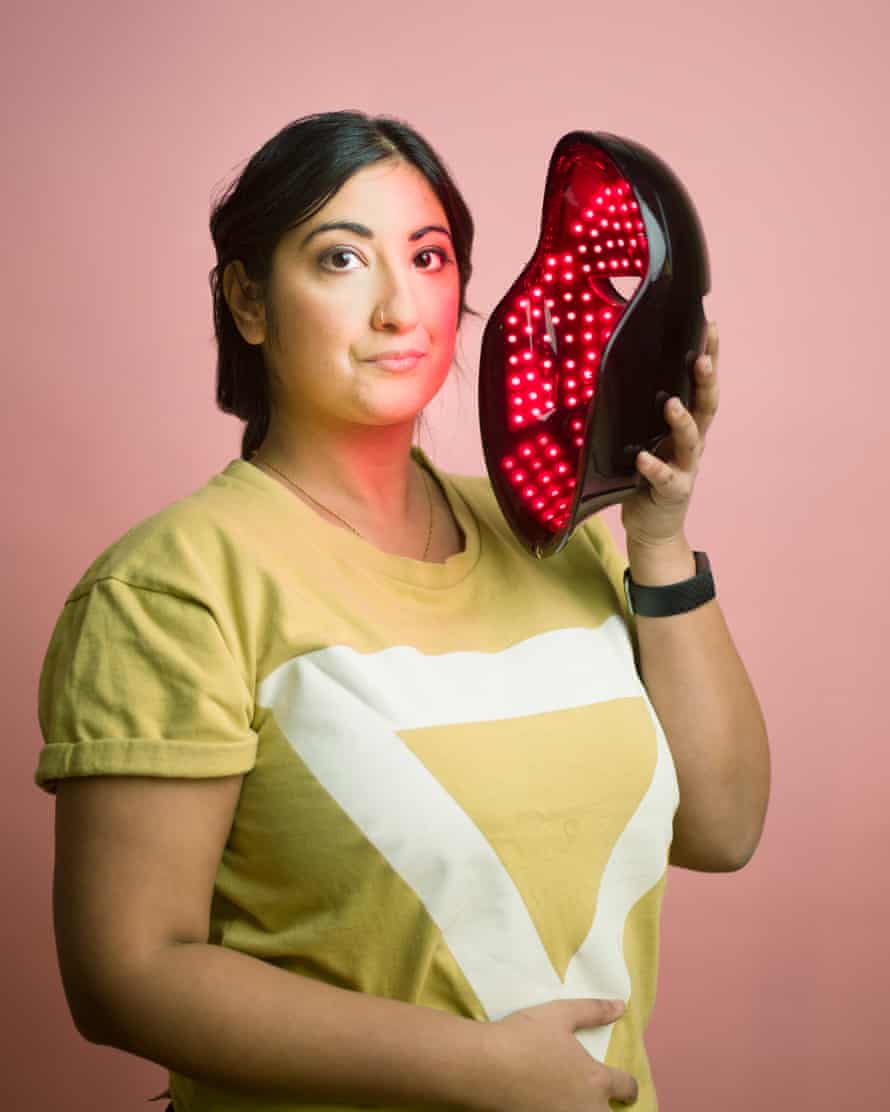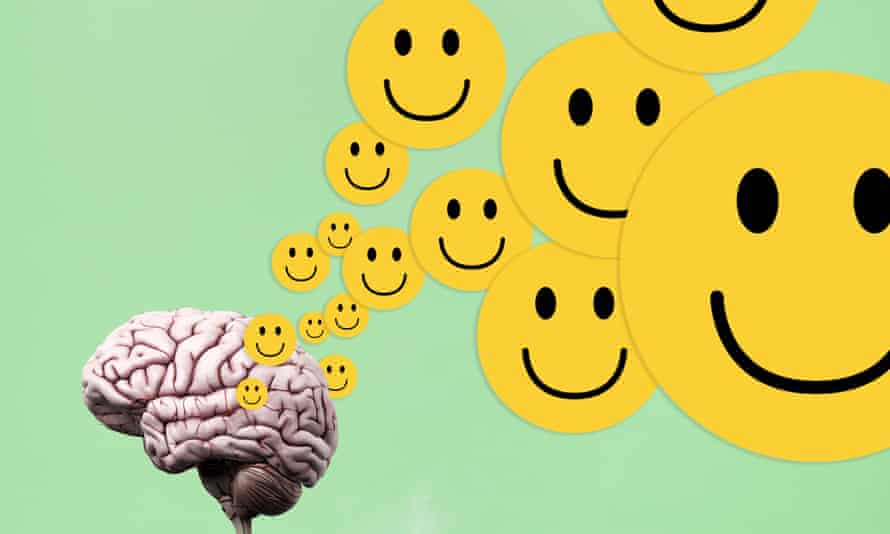Dopamine fasting
This is a productivity fad that has become popular with Silicon Valley types, including Twitter CEO Jack Dorsey. Dopamine is the brain’s “feelgood” neurotransmitter, released when we experience pleasure. The theory goes that we are constantly mentally aroused and so unable to focus. By denying ourselves such stimuli, we may be able to improve mental clarity and better appreciate pleasure when it comes.
So what’s off limits? It depends who you ask. Most versions involve swearing off booze, drugs, gaming, using your phone and TV, pornography and masturbation, as well as high-sugar foods and caffeine. Extreme practitioners will also eschew all food, exercise, technology and even eye contact.
I speak to Erica Madera, a YouTuber and aspiring influencer, who recently experimented with a three-day fast that prohibited internet and television. “But I was still feeling lots of dopamine,” she says, “from people. People are the biggest rushes. So I decided to cut out talking to people, too.”
I give my own fast a go. I wake up without my usual phone alarm, which is in itself enjoyable (although that is not quite the point). Instead of watching television, I read a book, which has me utterly gripped, and again I must remind myself of the objective. I go back to the chapter in which one of my favourite characters dies to flatten my mood.
I’d promised a friend I’d join them for a lunchtime stroll. It’s sunny and the air is soothing, crisp and chilled. In order to keep the dopamine low, I tell myself it’s heavily polluted and likely killing me. My friend is late, and I have no phone, so I watch the squirrels. They are too funny and devilish, so instead I look at the mud.
Then my friend rocks up, full of joie de vivre and clutching a housewarming gift, and I am unable to keep a lid on the dopamine. I try to do better for the rest of the day by focusing on errands such as renewing my parking permit and reading the dishwasher manual. But then my boyfriend tells me he is heading out, so I need to babysit our new kitten.
Of course, I needn’t have bothered with the fast, as the science would have told me had I checked first. Think of it like this: dopamine is a postman. When something great happens, the postman comes to deliver the brain its parcel of joy. Over time, the postman learns where it’s going to be deployed – when you eat chocolate, when you look at social media – so much so that even the thought of chocolate can get the postman jogging. But fasting from joy won’t reduce dopamine; the postman won’t get the sack. In a healthy brain, our trusty postie will simply be redeployed somewhere else. In short, there is no such thing as a dopamine fast. All you’re doing is giving your brain the chance to derive joy from a variety of sources.
And that has been helpful for some. “It made me realise just how much I used social media,” Madera says. “And it helped me focus on other projects I’ve procrastinated with.” She says she learned a lot from the experience and will take it further next time, eschewing other pleasures such as books and music. As for me, I returned to my regular life feeling the same: not reset, nor brimming with new appreciation for Netflix. Perhaps I need to do it for longer. But I’d better wait until my cat becomes less cute.
Verdict: 2/5 Five stars for being an enjoyable challenge, minus three for not really making sense.
LED face mask

I first came across LED face masks on Instagram, where famous types such as Julia Roberts and Chrissy Teigen ascribed their dewy complexions to this futuristic gizmo. In addition to making wearers look like Darth Vader during his years as a Berlin DJ, LED face masks promise to slow (and even reverse) the ageing process while reducing redness and scarring. They do this by exposing the skin to light at different wavelengths (which we see as different colours). Red light is supposed to stimulate collagen production in the skin; blue light is said to have antibacterial qualities, helping reduce acne.
I’m trying the Neomatrix face mask from UK brand Neo Elegance, founded by neurology graduate Farrah Allarakha. She started to manufacture masks after they solved some of her own skin woes, having noticed they were hard to come by. “The UK isn’t like Korea, or even France,” she says. “In those cultures women are thinking about anti-ageing much earlier.”
The Neomatrix has 690 bulbs, making it one of the most powerful masks on the market. It doesn’t come cheap, at £275-£500. For the first three weeks, I’m supposed to use my new weapon against ageing five times a week for 20 minutes after cleansing. It takes some getting used to: it has built-in breathing holes, but they don’t quite line up with my nose and mouth, so I can wear it only when I’m lying down. It feels heavy, but I cannot feel the heat of the bulbs too much, nor see them. (In July, Neutrogena recalled its Light Therapy Acne Mask after complaints it aggravated skin with light sensitivity.) I enjoy the lie down and take the opportunity to listen
to a podcast, but my skin doesn’t look any different. If anything, it feels drier, likely due to using face wash more than I usually would. I drop to using the mask twice a week.
For Lora Holtom, a mobile beauty therapist based in Surrey, the effects of the LED face mask were instant. “I use it to target cystic acne,” she says. “After one 30-minute session, there was visible improvement the next day.” Since then, she has been offering LED mask facials to her clients. “A lot of the [LED] facials I do are on girls in their 20s,” she says. “They’re thinking about forehead lines, but I’ve also seen an uptick in the self-care treatments which, instead of cosmetic results, make you feel good.”
I can’t help but wonder if spending money to fit an impossible, time-defying standard of beauty should count as “self-care”. And at the end of my trial I cannot see any difference. But I notice a hormonal period that would normally provoke a breakout has not. And, much as I hate to admit it, that does make me pretty happy.
Verdict: 3/5 I can’t be sure it works, but it might have done, and I look like I’m in Daft Punk. Result.
Beeja meditation

By 2018, Beeja meditation had become so popular, it was able to fill Fabric nightclub in London with 1,000 practising enthusiasts. The British man behind the movement is Will Williams, cheeky lad-turned wellness guru, whose sessions come packed with anecdotes of his drink, drug and sex-filled pre-Beeja life. (He assures us that a life with Beeja meditation can still involve sex: “You should see what happens on the retreats,” he jokes.)
Williams’ high-profile clients include Kate Winslet and newsreader Tom Bradby, and he enjoys cult status in the world of wellness. He’s charming, chilled and immensely approachable. I join his two-day beginners’ course online with a dozen others – mostly women, but some men – from the UK, US, Europe and Latin America.
Beeja is not vastly different from other meditations in terms of the end result: to get yourself into a clear, restful and meditative state. Some people use mindfulness techniques such as counting or listening to their breathing, whereas Beeja harnesses a Vedic method: you repeat a mantra, which is personal to you but given by the trained leader (in this case, Williams). At a real-life session, Williams would spend time getting to know you and then whisper it into your ear. Now, he gives you your mantra through WhatsApp audio, leaving you a voice note which he asks you to keep private and delete once you’ve memorised it.
The mantra method may not be for everyone, but it worked for me. The two-syllable word (which I can’t tell you, obviously) chimed perfectly with the natural rhythm of my own breath, and repeating it – in combination with Williams’ suggested visualisations of the body being anchored and feeling heavy – made it easy to slip into a restful state of mind. After our sessions I stuck to his “20 minutes, twice a day” rule for a few weeks, using the app as a timer.
Evangelists for meditation will say there is no ailment it cannot help. While that may be too extreme, there is ample evidence that meditation does have benefits, especially with physical and mental conditions exacerbated by stress.
Soon enough, my old ways returned. I replaced my twice-daily meditation session with my usual schedule of bad habits. But when I feel the need to hit pause on life, I return to my mantra to help me slip into a calm, restful meditation. And it works, every time.
Verdict: 4/5 It might not be the cure-all its staunch believers think it is – but it feels good, and is easy to practise on your own.
Manifesting

This is the belief that you can summon anything (a new job, a new partner, a car) through positive thinking, effectively using your willpower to materialise your desires. It’s enjoyed a boom since the first lockdown of 2020 and has had backing from celebs such as Jim Carrey, Lady Gaga and Oprah Winfrey. (Personally, I’d have thought astronomical wealth is how you will your desires into existence, but hey, I’m open to trying other methods.)
The foundation of the practice is in something manifesters call “the law of attraction”. They say that, just as quantum physics tells us all things are made of energy, so our thoughts are made of energy, too. Given that we can control our thoughts, we can therefore control some of that same energy (or “vibrations”, as they refer to it). The objective is to focus the mind on positive outcomes through visualisation: picture it in your mind in all its detail, write down exactly how it might happen, say it out loud and tell the universe you’re ready, with mantras. (Something like: “I am open and ready to receive money. Money is attracted to me and needs me to spend it.”)
“Last year, I would speak to the universe and say, ‘I really need a new client’ and a few days later I would get a call,” says Jennifer Sutcliffe, entrepreneur and communications director. “It was really weird. But it happened so often, I wouldn’t dispute it. Some people can go too far,” she says. “It should never replace medicine. And I don’t think I can manifest world peace – but maybe if all the world leaders did, we’d get somewhere.”
Sutcliffe practises a method outlined in Hal Elrod’s book The Miracle Morning: The Not-So-Obvious Secret Guaranteed To Transform Your Life (Before 8AM), which outlines six steps to do each morning: silence (for meditation), affirmations (reading positive statements out loud), visualisation, exercise, reading and scribing (which can be a diary entry or writing down your goals).
I decide to follow suit. The reading and exercise bits come naturally, and it’s nourishing to lock art and endorphins into my morning routine. The meditation part is a doddle, too – what with my new Beeja mantra – but I find the affirmations part challenging. I give it a go: “I am open and ready to be slimmer. Lower calorie intakes are attracted to me and I will master one.” I can’t take it seriously. But the visualisation and scribing parts are very productive. By having to imagine and write for 10 solid minutes about my desire to shift some pounds, I am forced to go into meticulous detail, to think about how I might do it.
They call it manifestation; I call it planning. Either way, it feels like progress. I keep going, but when I next weigh myself I’m a pound heavier. I look online for advice. From expensive consultations with manifestation experts to the sale of objects that are supposed to increase your own vibrational pull, I discover a whole industry around the practice. I read that burning “sacred herbs” can increase vibrations (in particular sage, which is presumably borrowed from Native American traditions), so I burn some incense while I do yoga. If anything, I feel hungrier.
I search Reddit for tips, unlocking hundreds of stories from people manifesting jobs in the pandemic. I feel a twinge of anger. Presumably we’re meant to think that those who didn’t magic up a new job just didn’t try hard enough.
Despite its vocabulary of ancient mystical terms, manifestation is a very modern affair – individualism writ large, where your social, physical and emotional condition is ultimately your own responsibility. Distinct from say, karma, where doing good brings good, manifestation requires giving little to the world but asking a lot from it. For a practice that’s supposed to make me happy, it sure is depressing.
Verdict: 1/5 Some psychological benefits but mostly a contradictory rip-off of other cultures, with an unhealthy dollop of selfishness.
Wim Hof

As wellness gurus go, few are as enigmatic as Wim Hof, the Dutch wellness leader known for completing superhuman feats in sub-zero conditions. He has run a barefoot marathon on ice and climbed Kilimanjaro in shoes and shorts, all thanks to his method of breathing, meditation, yoga and cold exposure, which he has been teaching since 2013.
Now 61, he is nothing short of a global phenomenon: legions of fans, widespread press coverage and a point of interest for scientists who are keen to understand whether his method is madness. Hof claims that his technique can help, well, everything – from anxiety to obesity, MS to Parkinson’s, insomnia to poor concentration. Scientists who studied him found his method does do something: it tricks his body into producing a stress response, releasing opioids and cannabinoids, which helps him resist the effects of cold.
Critics of Hof say tha
t he gives false hope to people with serious conditions. And there have been deaths. Relatives of four Wim Hof Method fans who drowned between 2015 and 2016 have blamed the breathing exercises. (Hof’s spokesperson said that Hof was ‘devastated’ by these cases and that he has always made it clear that people should not attempt such exercises in water.)
Personally, my interest in better tolerating cold is solely so I can put an end to the daily arguments over the thermostat at home (maybe if I can find zen in ice, I can tolerate my partner’s shockingly poor heating standards). I sign up for the 10-week online video course. The yoga and meditation parts are fine – familiar, even. And I enjoy the breathing practice: a combination of deep but quick breaths that Hof describes as “controlled hyperventilation” or “power breathing” alongside breath retention. The aim is to get more air into the lungs (“Breathe in! Fully in!” Hof commands), to oxygenate the blood. My body starts to tingle. I feel dizzy but my mind is clear, light and without any panic – it’s a kind of happy giddiness. In short: I feel high.
But the cold exposure training feels insurmountable. Hof tells me to start by switching my regular shower to cold for 30 seconds. My shower stutters as it blasts me with icy water. I scream. My warm, relaxed body clenches up tightly, and I throw my arms around myself, teeth gritted. And far from feeling invigorated, I feel annoyed. Hot showers and baths have always been sacred to me. I emerge from them triumphant, transformed into a smooth yet mighty goddess, hair swaddled and flesh wrapped in cotton. But with Wim Hof, I emerge a shivering mess. I keep trying, but cannot hack it for more than 45 seconds.
“If you can get to two minutes, you’ll start to notice the difference,” says Chris Holmes, an osteopath in Northumberland who has embraced the method so much, he’s got an ice-bath in his back garden. “They actually talked about the anti-inflammatory qualities of cold water when I was training,” he says. The more he investigated, the more the science stacked up. “This method engages the endocannabinoid system. We’re still learning about that system, but we know that happiness is helpful for pain management.”
In a video from March 2020 – near the beginning of the pandemic – Hof enthused about his method’s ability to raise immunity. But in general, exposure to cold is not recommended for people with low immunity, as there is evidence it suppresses the immune system. Isn’t this irresponsible, I ask Holmes? “He’s trying to give people back some control at a time when it’s being taken away from them,” Holmes says. “And it is fair to say Covid impacts people with underlying conditions, so doing things to build overall health, especially mental health, can’t hurt.”
He gives me a tip. When the shower turns cold, start with your hands and feet – let them acclimatise, then step in. I practise my breathing, then give it a go, hitting two minutes easily. I bound out of the shower totally reinvigorated and energised, with a renewed sense of confidence in my ability to withstand what life throws at me. Beginner’s luck? Or something deeper? I cannot say. But I do know my next shower will be a cold one.
Verdict: 3/5 A rare wellness practice that incorporates mind and body, even if the science isn’t quite there to back it. Bloody freezing, though.

/cdn.vox-cdn.com/uploads/chorus_image/image/62810996/Amm_DeepSentinel_01.0.jpg)

More Stories
Food to Eat and to Avoid After Receiving Dental Implants
The Risks and Dangers of Manual Pupil Evaluation in Neurological Treatment
At Home Bleeding Gum Care